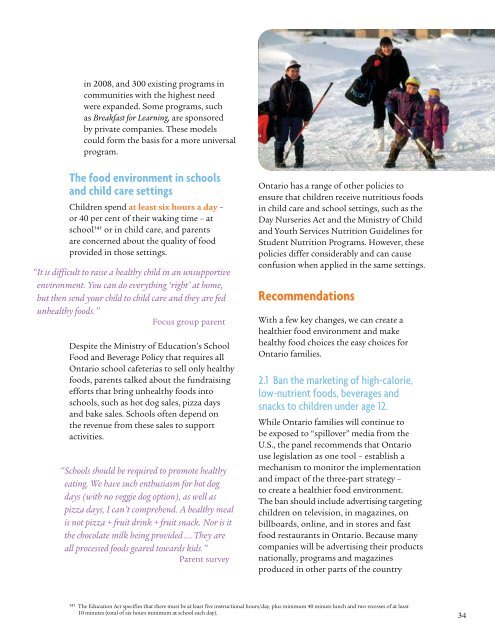No Time to Wait: The Health Kids Strategy - Ontario
No Time to Wait: The Health Kids Strategy - Ontario
No Time to Wait: The Health Kids Strategy - Ontario
- No tags were found...
You also want an ePaper? Increase the reach of your titles
YUMPU automatically turns print PDFs into web optimized ePapers that Google loves.
in 2008, and 300 existing programs incommunities with the highest needwere expanded. Some programs, suchas Breakfast for Learning, are sponsoredby private companies. <strong>The</strong>se modelscould form the basis for a more universalprogram.<strong>The</strong> food environment in schoolsand child care settingsChildren spend at least six hours a day –or 40 per cent of their waking time – atschool 141 or in child care, and parentsare concerned about the quality of foodprovided in those settings.“ It is difficult <strong>to</strong> raise a healthy child in an unsupportiveenvironment. You can do everything ‘right’ at home,but then send your child <strong>to</strong> child care and they are fedunhealthy foods.”Focus group parentDespite the Ministry of Education’s SchoolFood and Beverage Policy that requires all<strong>Ontario</strong> school cafeterias <strong>to</strong> sell only healthyfoods, parents talked about the fundraisingefforts that bring unhealthy foods in<strong>to</strong>schools, such as hot dog sales, pizza daysand bake sales. Schools often depend onthe revenue from these sales <strong>to</strong> supportactivities.“ Schools should be required <strong>to</strong> promote healthyeating. We have such enthusiasm for hot dogdays (with no veggie dog option), as well aspizza days, I can’t comprehend. A healthy mealis not pizza + fruit drink + fruit snack. <strong>No</strong>r is itthe chocolate milk being provided .... <strong>The</strong>y areall processed foods geared <strong>to</strong>wards kids.”Parent survey<strong>Ontario</strong> has a range of other policies <strong>to</strong>ensure that children receive nutritious foodsin child care and school settings, such as theDay Nurseries Act and the Ministry of Childand Youth Services Nutrition Guidelines forStudent Nutrition Programs. However, thesepolicies differ considerably and can causeconfusion when applied in the same settings.RecommendationsWith a few key changes, we can create ahealthier food environment and makehealthy food choices the easy choices for<strong>Ontario</strong> families.2.1 Ban the marketing of high-calorie,low-nutrient foods, beverages andsnacks <strong>to</strong> children under age 12.While <strong>Ontario</strong> families will continue <strong>to</strong>be exposed <strong>to</strong> “spillover” media from theU.S., the panel recommends that <strong>Ontario</strong>use legislation as one <strong>to</strong>ol – establish amechanism <strong>to</strong> moni<strong>to</strong>r the implementationand impact of the three-part strategy –<strong>to</strong> create a healthier food environment.<strong>The</strong> ban should include advertising targetingchildren on television, in magazines, onbillboards, online, and in s<strong>to</strong>res and fastfood restaurants in <strong>Ontario</strong>. Because manycompanies will be advertising their productsnationally, programs and magazinesproduced in other parts of the country141 <strong>The</strong> Education Act specifies that there must be at least five instructional hours/day, plus minimum 40 minute lunch and two recesses of at least10 minutes (<strong>to</strong>tal of six hours minimum at school each day).34
















